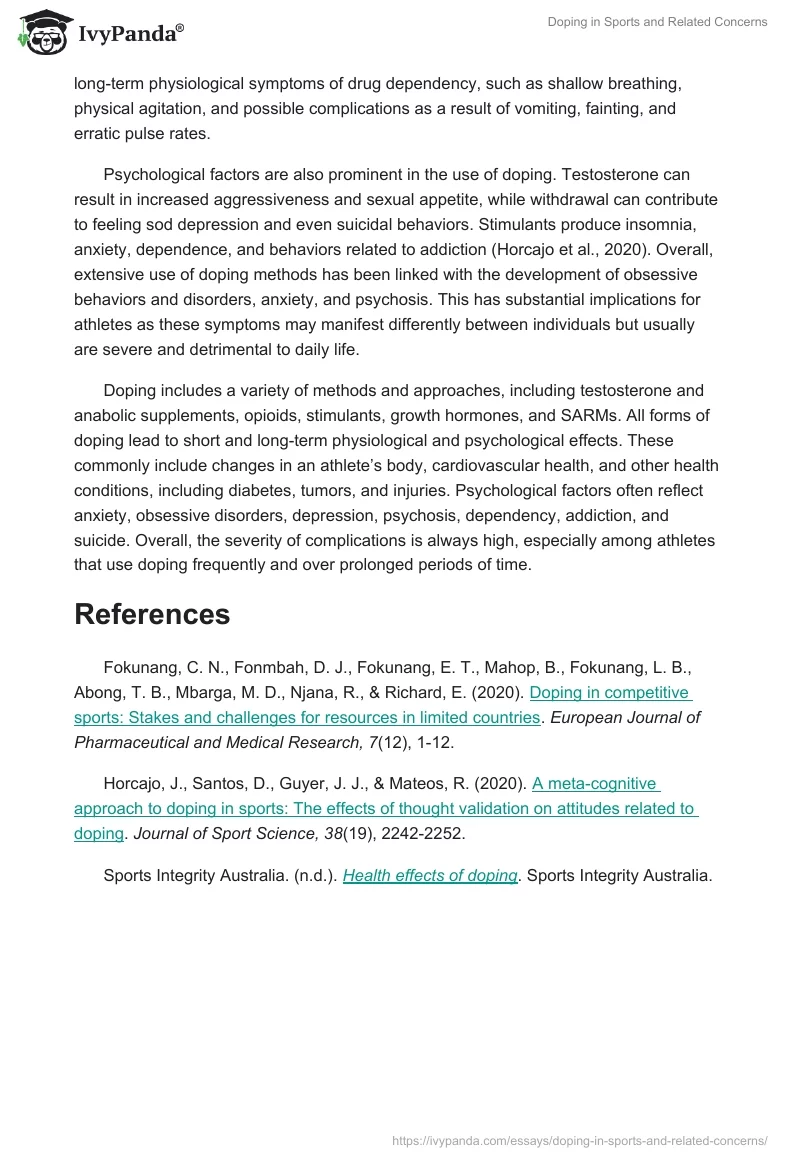Doping refers to using drugs, stimulants, or other substances to improve or enhance one’s sporting performance. Doping may be accessed through a number of measures, including testosterone and anabolic agents, growth hormones, blood doping, opioids, and Selective Androgen Receptor Modulators, or SARMs. While all of the aforementioned substances may provide athletes with competitive advantages, they introduce ethical concerns and psychological and physical harm. These issues may be categorized through their symptoms which may either be immediate psychological, psychological, or long-term physical injuries and health complications. Because doping provides various methods, each substance manifests more unique symptoms, but many health issues are also shared between users of the aforementioned stimulants and substances.
Testosterone has immediate or short-term effects that appear differently for each gender. Female athletes may see a deepening of the voice, no breast development, growth of facial hair, and an abnormal menstrual cycle. Male athletes have the potential to observe breast tissue development, impotence, and reduction in sperm production. SARMs can cause hypertension, heart attacks, severe headaches, loss of vision, and thyroid issues (Sports Integrity Australia, n.d.). Blood doping results in stress on the heart, strokes, blood clotting, and pulmonary embolisms. Weight loss, dehydration, and tremors may follow symptoms related to cardiovascular functions. Opioid use can result in nausea, vomiting, constipation, loss of balance, a suppressed respiratory system, and a lack of coordination. These only reflect the initial symptoms that may be witnessed throughout a number of phases of doping use. Studies suggest continuous use likely exacerbates immediate issues and contributes to lifelong risks.
Doping may form long-term illnesses and health complications, most of which will be treatable but not compatible with competitive sports lifestyles. Testosterone and anabolic supplements can lead to severe liver damage. Lifelong issues as a result of growth hormone use can create dangers of diabetes, tumor formations, arthritis, acromegaly, and a varied number of cardiovascular conditions such as high blood pressure, hypertension, and increased risk of heart attacks (Fokunang et al., 2020). Blood doping and stimulants contribute to the likelihood of worsening heart conditions and also vastly increase the risk of a heart attack or failure. Opioid use suggests the long-term physiological symptoms of drug dependency, such as shallow breathing, physical agitation, and possible complications as a result of vomiting, fainting, and erratic pulse rates.
Psychological factors are also prominent in the use of doping. Testosterone can result in increased aggressiveness and sexual appetite, while withdrawal can contribute to feeling sod depression and even suicidal behaviors. Stimulants produce insomnia, anxiety, dependence, and behaviors related to addiction (Horcajo et al., 2020). Overall, extensive use of doping methods has been linked with the development of obsessive behaviors and disorders, anxiety, and psychosis. This has substantial implications for athletes as these symptoms may manifest differently between individuals but usually are severe and detrimental to daily life.
Doping includes a variety of methods and approaches, including testosterone and anabolic supplements, opioids, stimulants, growth hormones, and SARMs. All forms of doping lead to short and long-term physiological and psychological effects. These commonly include changes in an athlete’s body, cardiovascular health, and other health conditions, including diabetes, tumors, and injuries. Psychological factors often reflect anxiety, obsessive disorders, depression, psychosis, dependency, addiction, and suicide. Overall, the severity of complications is always high, especially among athletes that use doping frequently and over prolonged periods of time.
References
Fokunang, C. N., Fonmbah, D. J., Fokunang, E. T., Mahop, B., Fokunang, L. B., Abong, T. B., Mbarga, M. D., Njana, R., & Richard, E. (2020). Doping in competitive sports: Stakes and challenges for resources in limited countries. European Journal of Pharmaceutical and Medical Research, 7(12), 1-12.
Horcajo, J., Santos, D., Guyer, J. J., & Mateos, R. (2020). A meta-cognitive approach to doping in sports: The effects of thought validation on attitudes related to doping. Journal of Sport Science, 38(19), 2242-2252.
Sports Integrity Australia. (n.d.).Health effects of doping. Sports Integrity Australia.


